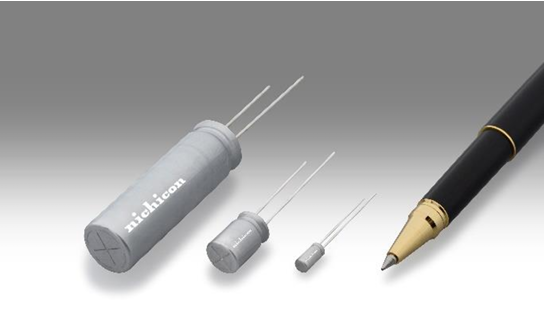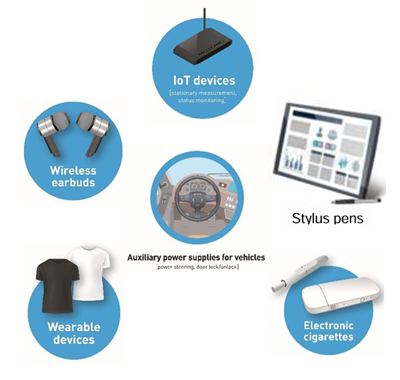NICHICON Launches SLB Series of New Energy Storage Devices Optimized for the IoT Market
Author: Nichicon
7/31/2019
The market for the Internet of Things (IoT) is expected to grow substantially in the coming years as, with IoT technology is utilized in increasingly broad situations. This is prompted by the launch of fifth-generation (5G) communications, which enables high-speed, large capacity, low-inactivity, and multi-connectivity networks, It allows for the spread of low-cost, low-power-consumption communication networks such as low-power wide-area (LPWA) networks. When IoT sensors are installed in areas where a stable supply of power is unavailable, the use of energy storage devices is required. Primary (non-rechargeable) batteries are often used, but they need to be replaced due to their short lifespan. Replacing primary batteries with secondary (rechargeable) batteries and integrating them with energy harvesting devices that convert light, heat, vibration, and radio wave energies into electricity can create an independent, maintenance-free system to power IoT sensors. This has increased the market demand for rechargeable batteries optimized for IoT sensor applications.
NICHICON’s SLB Series of new energy storage devices is ideal for IoT applications. It is capable of low current charge and high current discharge, and has an extended lifespan with excellent cycle characteristics. The SLB Series has a lower internal resistance than traditional lithium-ion rechargeable batteries. The currents generated by energy harvesting devices are usually small, giving the SLB series an advantage over other rechargeable batteries. The SLB Series can discharge high-current power instantly due to its low internal resistance.
IoT data is collected using various communication methods, and the power needed to transmit this data differs based on the volume of information and transmission distance. This results in greater power consumption and higher currents. For conventional lithium-ion rechargeable batteries to release high currents is to expand their capacities and their size must be expanded. The SLB Series, however, despite its compact size. The SLB Series allows more than ten times the number of charge/discharge cycles compared to traditional lithium-ion rechargeable batteries, which reduces the need for maintenance.
NICHICON’s SLB Series is cylindrical in shape, and offers case styles identical to Nichicon’s electrolytic capacitors. It’s compromised of a positive electrode, a negative electrode, a separator, an electrolytic solution, and an exterior material that houses these components. The positive and negative electrodes are formed by coating thin metal foils with active materials for each electrode. The active material for the negative electrode is lithium titanate oxide (LTO), which has greater thermal stability than the carbon-based materials used in many lithium-ion rechargeable batteries and is non-flammable. Thermal runaway is low because no reaction occurs between the LTO in the negative electrode and electrolytic solution even at high temperatures LTO transitions to a near-insulating state when lithium ions are released. Even if a short circuit occurs in some parts of the battery, it does not spread throughout the battery because the surface of the LTO around the short circuit area becomes insulated and prevents discharge reactions from progressing. Even in the event of an internal short circuit, exothermic reactions are greatly suppressed.
.png)
SLB Series of small lithium-ion rechargeable batteries
The technology for the SLB Series comes from Toshiba Infrastructure Systems & Solutions Corporation’s SCiBTM rechargeable battery technology. By using LTO for the negative electrode, the SLB Series of small lithium-ion rechargeable batteries can charge and discharge rapidly at high rates up to 20 C resulting in input/output densities close to that of electric double-layer capacitors. They have long lifespans with over 25,000 charge/discharge cycles at the rate of 10 C, and can function at low temperatures as low as -30 °C. Because the formation of lithium salts—which causes short circuits and battery degradation—rarely occur, the risk of fire or explosion is extremely low, this makes the SLB safe.
Key features of the SLB Series of small lithium-ion rechargeable batteries
.png?lang=en-US&height=380&width=400)
-
Long life
Maintains over 80% of its’ initial capacity after 25,000 charge/discharge cycles -
Rapid charging and discharging
Can be charged to roughly 80% capacity in three minutes -
Low-temperature performance
Can be charged and discharged at temperatures as low as -30 °C -
Safety
Low risk of fire or explosion even in the case of forced internal short circuit
NICHICON launched the SLB Series of lithium-ion rechargeable batteries in the dimension φ3 x 7L (mm). The company plans to launch products in the same series with dimensions φ8 x 11.5L (mm) and φ12.5 x 40L (mm) in the near future.